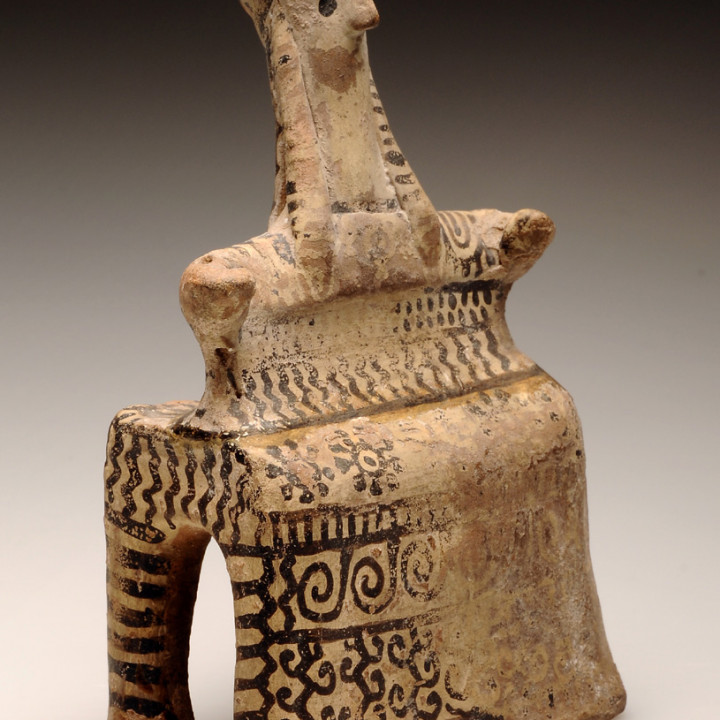
Thronendes Brettidol
myminifactory
The female idol is seated on a chair without a backrest, from which one can see the two rear legs with a pattern of horizontal lines and the seat, which is decorated with a pattern of waves and parallel lines. The body is flat. The arm stumps are curved inwards; a hole for flowers or other attributes on each arm. The head develops from an elongated neck. The nose is sculpted, eyes and a spiral curl are painted. The head is crowned by a stephane, the front volute - see the Boeotian board idols - is missing. The plastically reproduced mass of hair is designed with vertical zigzag lines on the back and in the form of braids with horizontal lines on the front. A chain with a faded pendant runs around the neck. Eight horizontal zones divide the front of the robe: the shoulder has concentric semi-ovals followed by a double row of dots, then a vertical zigzag band, rosettes, vertical lines, again a vertical zigzag line with spirals, and finally a double row of points. The seated idol is closely related to the bird-faced board idols. Like the board idols, the enthroned idol also represents an ancient deity. Pausanias (2, 17, 5) reports an ancient seated image of Hera carved from pear wood in the Heraion of Argos. Her function as a deity of vegetation, combining decay, death and resurrection, could perhaps have been additionally marked by branches, flowers or ears of corn held in her hands. The shoulder shows concentric semi-ovals, followed by a double row of dots, then a vertical zigzag band, rosettes, vertical bars, again a vertical zigzag line with spirals and finally a double row of dots. The seated idol is closely related to the bird-faced board idols. Like the board idols, the enthroned idol also represents an ancient deity. Pausanias (2, 17, 5) reports an ancient seated image of Hera carved from pear wood in the Heraion of Argos. Her function as a deity of vegetation, combining decay, death and resurrection, could perhaps have been additionally marked by branches, flowers or ears of corn held in her hands. The shoulder shows concentric semi-ovals, followed by a double row of dots, then a vertical zigzag band, rosettes, vertical bars, again a vertical zigzag line with spirals and finally a double row of dots. The seated idol is closely related to the bird-faced board idols. Like the board idols, the enthroned idol also represents an ancient deity. Pausanias (2, 17, 5) reports an ancient seated image of Hera carved from pear wood in the Heraion of Argos. Her function as a deity of vegetation, combining decay, death and resurrection, could perhaps have been additionally marked by branches, flowers or ears of corn held in her hands. then a vertical zigzag band, rosettes, vertical lines, again a vertical zigzag line with spirals, and finally a double row of dots. The seated idol is closely related to the bird-faced board idols. Like the board idols, the enthroned idol also represents an ancient deity. Pausanias (2, 17, 5) reports an ancient seated image of Hera carved from pear wood in the Heraion of Argos. Her function as a deity of vegetation, combining decay, death and resurrection, could perhaps have been additionally marked by branches, flowers or ears of corn held in her hands. then a vertical zigzag band, rosettes, vertical lines, again a vertical zigzag line with spirals, and finally a double row of dots. The seated idol is closely related to the bird-faced board idols. Like the board idols, the enthroned idol also represents an ancient deity. Pausanias (2, 17, 5) reports an ancient seated image of Hera carved from pear wood in the Heraion of Argos. Her function as a deity of vegetation, combining decay, death and resurrection, could perhaps have been additionally marked by branches, flowers or ears of corn held in her hands. The seated idol is closely related to the bird-faced board idols. Like the board idols, the enthroned idol also represents an ancient deity. Pausanias (2, 17, 5) reports an ancient seated image of Hera carved from pear wood in the Heraion of Argos. Her function as a deity of vegetation, combining decay, death and resurrection, could perhaps have been additionally marked by branches, flowers or ears of corn held in her hands. The seated idol is closely related to the bird-faced board idols. Like the board idols, the enthroned idol also represents an ancient deity. Pausanias (2, 17, 5) reports an ancient seated image of Hera carved from pear wood in the Heraion of Argos. Her function as a deity of vegetation, combining decay, death and resurrection, could perhaps have been additionally marked by branches, flowers or ears of corn held in her hands.
With this file you will be able to print Thronendes Brettidol with your 3D printer. Click on the button and save the file on your computer to work, edit or customize your design. You can also find more 3D designs for printers on Thronendes Brettidol.
